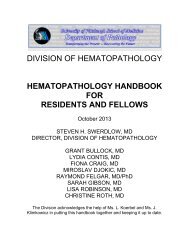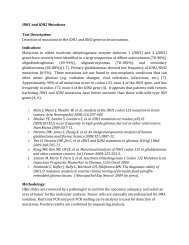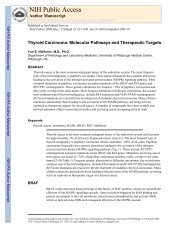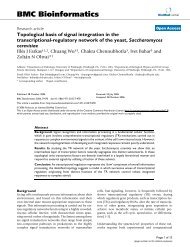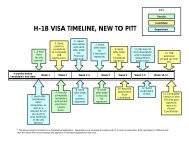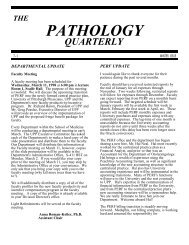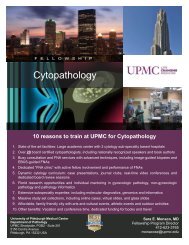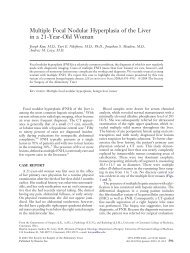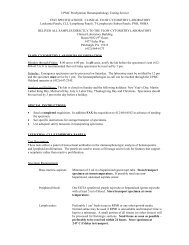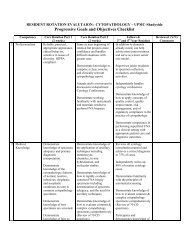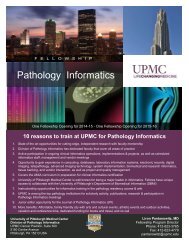Oncogenic AKAP9-BRAF fusion is a novel mechanism of MAPK ...
Oncogenic AKAP9-BRAF fusion is a novel mechanism of MAPK ...
Oncogenic AKAP9-BRAF fusion is a novel mechanism of MAPK ...
Create successful ePaper yourself
Turn your PDF publications into a flip-book with our unique Google optimized e-Paper software.
esearch article<br />
The vast majority <strong>of</strong> RET/PTC and all TRK and <strong>AKAP9</strong>-<strong>BRAF</strong><br />
chromosomal rearrangements in radiation-induced tumors are<br />
paracentric inversions. In epithelial cancers as a whole, point<br />
mutations are more prevalent than chromosomal rearrangements,<br />
and the latter are usually translocations or interchromosomal<br />
exchanges. The reason for the striking pred<strong>is</strong>position <strong>of</strong><br />
radiation-induced thyroid cancers to paracentric inversions <strong>is</strong> not<br />
entirely clear, although some evidence suggests that th<strong>is</strong> may be<br />
related to the organization <strong>of</strong> chromosomal domains and arm<br />
domains and spatial interaction between pairs <strong>of</strong> various chromosomal<br />
regions. Indeed, there <strong>is</strong> a general consensus that free DNA<br />
ends produced in the nuclear volume after passage <strong>of</strong> radiation<br />
tracks have to be within a certain d<strong>is</strong>tance <strong>of</strong> each other in order<br />
to recombine (43, 44). Residing within the same chromosomal<br />
arm domain would limit their maximum separation and help to<br />
fulfill th<strong>is</strong> requirement. Indeed, the yields <strong>of</strong> intra-arm chromosomal<br />
exchanges after both low– and high–linear energy transfer<br />
radiation has been shown to exceed the expected levels, calculated<br />
based on spatial randomness, by up to 10-fold (45). The conditions<br />
would be even more favorable if potentially recombinogenic<br />
foci within the arm domain were frequently juxtaposed to each<br />
other, as was demonstrated in human thyroid cells for RET and<br />
H4, the RET/PTC1 partners (46).<br />
In th<strong>is</strong> study, we observed significant difference in mechan<strong>is</strong>ms<br />
<strong>of</strong> <strong>BRAF</strong> activation not only between early radiation–associated<br />
tumors and sporadic cancers, but also between early and<br />
late post-radiation tumors. Such a difference <strong>is</strong> not without<br />
precedent. Similar variation has been previously observed with<br />
respect to RET/PTC rearrangements between post-Chernobyl<br />
tumors developing 10 years or less after exposure and those<br />
manifesting after a longer latency (34, 35). Indeed, the overall<br />
prevalence <strong>of</strong> RET/PTC was significantly higher in the former<br />
group, and RET/PTC3 was the most common type. By contrast,<br />
tumors ar<strong>is</strong>ing after a longer latency had lower prevalence <strong>of</strong><br />
RET/PTC, and the predominant type was RET/PTC1, both <strong>of</strong><br />
which are features more typical <strong>of</strong> sporadic tumors. The present<br />
study demonstrates that late post-radiation tumors also occupy<br />
an intermediate position with respect to the predominant<br />
mechan<strong>is</strong>m <strong>of</strong> <strong>BRAF</strong> activation. Th<strong>is</strong> suggests that tumors ar<strong>is</strong>ing<br />
early after exposure are likely to be initiated through direct<br />
radiation damage–related genetic events, such as chromosomal<br />
rearrangements occurring after double-stranded DNA breaks.<br />
As for the tumors developing after a longer latency, their pathogenes<strong>is</strong><br />
may involve a combination <strong>of</strong> radiation-related and<br />
-unrelated mechan<strong>is</strong>ms and rely on molecular alterations which<br />
develop after repair <strong>of</strong> radiation-induced DNA damage that are<br />
stimulated by genomic instability that pers<strong>is</strong>ts in the progeny <strong>of</strong><br />
the exposed cells (47, 48).<br />
In summary, we report here a <strong>novel</strong> mechan<strong>is</strong>m <strong>of</strong> in vivo <strong>BRAF</strong><br />
activation via inversion <strong>of</strong> chromosome 7q, resulting in <strong>BRAF</strong><br />
<strong>fusion</strong> to the <strong>AKAP9</strong> gene. <strong>AKAP9</strong>-<strong>BRAF</strong> functions as an oncogene<br />
and <strong>is</strong> more prevalent in thyroid carcinomas with recent h<strong>is</strong>tory<br />
<strong>of</strong> radiation exposure. The significance <strong>of</strong> th<strong>is</strong> study <strong>is</strong> 2-fold. It<br />
demonstrates a <strong>novel</strong> mechan<strong>is</strong>m <strong>of</strong> <strong>BRAF</strong> activation in human<br />
tumors, showing for the first time that intracellular effectors<br />
along the <strong>MAPK</strong> pathway can be activated by recombination. In<br />
addition, it shows correlation between the nature <strong>of</strong> the mutagen<br />
and the mechan<strong>is</strong>m <strong>of</strong> mutation and suggests that paracentric<br />
chromosomal inversions represent a common genetic mechan<strong>is</strong>m<br />
<strong>of</strong> radiation-associated thyroid carcinogenes<strong>is</strong>.<br />
Methods<br />
Tumor samples. Frozen t<strong>is</strong>sues from sporadic thyroid carcinomas were<br />
obtained from the Department <strong>of</strong> Pathology, University <strong>of</strong> Cincinnati,<br />
following an institutionally approved t<strong>is</strong>sue procurement protocol<br />
and through the Cooperative Human T<strong>is</strong>sue Network. Post-Chernobyl<br />
tumors from Belarussian patients who underwent surgery in 1991–92<br />
were available as archival paraffin-embedded t<strong>is</strong>sue. Samples from<br />
Belarussian patients who underwent surgery in 1995–1998 were from<br />
the Experimental Div<strong>is</strong>ion <strong>of</strong> the Institute <strong>of</strong> Pathology, University <strong>of</strong><br />
Munich, and available as RNA extracted from frozen t<strong>is</strong>sue; they were<br />
negative for RET/PTC and TRK rearrangements (35). The study was<br />
approved by the University <strong>of</strong> Cincinnati Institutional Review Board.<br />
FISH analys<strong>is</strong>. Tumor touch preparations were made from snap-frozen<br />
t<strong>is</strong>sues. PAC clones for <strong>BRAF</strong> (RP4-726N20, RP5-839B19, RP4-813F11)<br />
were obtained from BAC/PAC Resources, Children’s Hospital Oakland,<br />
and bacterial artificial chromosome (BAC) clones for <strong>AKAP9</strong> (CTB-104F4,<br />
CTB-161K23) from Open Biosystems. The probes were labeled by nick<br />
translation using SpectrumOrange-dUTP and SpectrumGreen-dUTP<br />
(Vys<strong>is</strong> Inc.), respectively. An α-satellite DNA centromeric probe for chromosome<br />
7 was obtained from Vys<strong>is</strong> Inc. Nuclei were counterstained with<br />
DAPI. Microscopy was performed with a Leica Microsystems TCS 4D confocal<br />
laser scanning fluorescence microscope with digital image capture.<br />
One hundred nuclei were scored for each preparation.<br />
5′ RACE. Fifty micrograms <strong>of</strong> poly(A) + RNA from the index case were used<br />
for 5′ RACE using the 5′ RACE System for Rapid Amplification <strong>of</strong> cDNA<br />
Ends (Invitrogen Corp.). The <strong>BRAF</strong> gene–specific primers were designed<br />
for cDNA synthes<strong>is</strong> (5′-GATGACTTCTGGTGCCATCC-3′, 5′-AACTGCT-<br />
GAGGTGTAGGTGCTGTC-3′, and 5′-GTCTCGTTGCCCAAATTGAT-3′)<br />
and for subsequent PCR reactions (5′-TTTCACTGCCACATCACCAT-3′ for<br />
first PCR and 5′-TCACTCGAGTCCCGTCTACC-3′ for nested PCR). The 5′<br />
RACE products were exc<strong>is</strong>ed from the gel, purified, and sequenced using an<br />
automated ABI 377 sequencer (PerkinElmer).<br />
Cloning and sequencing analys<strong>is</strong>. Total RNA was used to amplify the ORF<br />
<strong>of</strong> the chimeric cDNA using primers located in the 5′-untranslated region<br />
<strong>of</strong> <strong>AKAP9</strong> (5′-ACCACCCCTCAACCCCTGTTTT-3′) and 3′-untranslated<br />
region <strong>of</strong> <strong>BRAF</strong> (5′-TTCCTTTTGTTGCTACTCTCCTGA-3′). The PCR<br />
product was electrophoresed in an agarose gel, purified from the gel, and<br />
cloned into the pCR-XL-TOPO vector (Invitrogen Corp.). Several clones<br />
were fully sequenced. The genomic <strong>AKAP9</strong>-<strong>BRAF</strong> <strong>fusion</strong> was amplified with<br />
primers 5′-GCAACTCAACCAAGTGAAAATG-3′ and 5′-GGTTGATCCTC-<br />
CATCACCAC-3′, yielding a product <strong>of</strong> approximately 2.4 kb, and the<br />
reciprocal <strong>fusion</strong> product cDNA was amplified with primers 5′-ACCC-<br />
GCCTCGGACTCTATT-3′ and 5′-GTTGGGCTTCCATCTGTAGC-3′,<br />
yielding a product <strong>of</strong> 242 bp.<br />
Western blot and immunoh<strong>is</strong>tochem<strong>is</strong>try. Frozen t<strong>is</strong>sues from papillary carcinomas<br />
were used for Western blotting, which was performed as previously<br />
described (49). We loaded 50 μg <strong>of</strong> protein on a 5% polyacrylamide<br />
gel. After transfer, the membranes were incubated with anti–C-terminus<br />
<strong>BRAF</strong> polyclonal (Raf-B, C-19; Santa Cruz Biotechnology Inc.) or anti–Nterminus<br />
<strong>AKAP9</strong> monoclonal (AKAP450; BD Biosciences) antibodies. The<br />
same <strong>AKAP9</strong> antibody in 1:50 dilution was used for immunoh<strong>is</strong>tochemical<br />
analys<strong>is</strong>, which was performed on paraffin sections after overnight pretreatment<br />
in borate buffer using avidin-streptavidin immunoperoxidase<br />
detection. Rabbit anti–γ-tubulin polyclonal antibody was provided by K.<br />
Fukasawa (University <strong>of</strong> Cincinnati College <strong>of</strong> Medicine, Cincinnati, Ohio,<br />
USA) (50) and was used in 1:800 dilution on paraffin sections after pretreatment<br />
in borate buffer.<br />
In vitro kinase assay. COS7 cells were transiently cotransfected with either<br />
pEFP vector or pEFP-containing myc-tagged <strong>BRAF</strong> WT , <strong>AKAP9</strong>-<strong>BRAF</strong>, or<br />
<strong>BRAF</strong> V600E and either pBabe puro or pBabe puro–HRAS G12V using Lipo-<br />
The Journal <strong>of</strong> Clinical Investigation http://www.jci.org Volume 115 Number 1 January 2005 99



